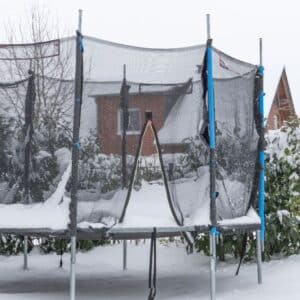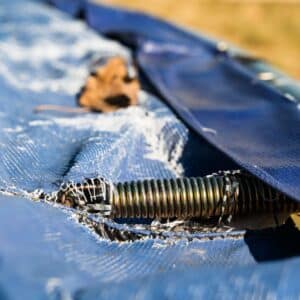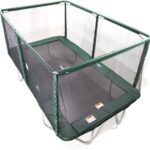Winter is not just a season of snow and cozy firesides; it’s also a time when our beloved outdoor equipment needs extra care to survive the harsh elements. Among these, trampolines, often the centerpiece of backyard fun, require special attention. If you’re wondering over how to winterize a trampoline, you’re already taking a crucial step towards preserving your investment and extending the lifespan of your trampoline.

Key Takeaways
- Understand the significance of trampoline winterization for durability and safety.
- Learn a step-by-step process for trampoline care during winter.
- Discover safety tips for using your trampoline in colder months.
Definition of Winterizing Your Trampoline
Winterization of a trampoline is an essential process for anyone looking to extend the lifespan of their outdoor trampoline. It involves a series of steps to protect the trampoline from the damaging effects of cold, snow, and strong winds. Given that certain parts of the trampoline, like the frame pads and jumping mat, are more prone to damage during winter, proper winterization is crucial.
Trampolines are made to be used in warm weather, and they are not designed to withstand the cold and snow. Winterizing your trampoline will help protect it from the elements, preventing damage and prolonging its lifespan.

Benefits of Winterizing Your Trampoline
Winterizing your trampoline has several benefits, including:
- Protection from harsh weather conditions
- Prevention of rust and corrosion
- Longevity of trampoline parts
- Safe storage until next use
Safety Precautions
Before you start winterizing your trampoline, it is important to take some safety precautions to avoid accidents.
Make sure that the trampoline is clean and dry before you start disassembling it. Check for any damage or wear and tear, and repair or replace any damaged parts.
Wear protective gloves and goggles to protect your hands and eyes while handling the trampoline components.
Safety Tips:
- Do not attempt to winterize your trampoline in windy or wet weather conditions.
- Make sure that there is no one on the trampoline while you are disassembling it.
- Use a ladder or step stool to reach the higher parts of the trampoline.
Steps to Winterize Your Trampoline
- Clean the trampoline. Begin your trampoline winterization process by thoroughly cleaning it. Remove all dirt and debris, and focus on eliminating stubborn stains on the springs or foam padding. Rust spots on metal parts, a common issue during damp conditions, should be scrubbed and rinsed off. This step ensures that your trampoline is not only clean but also free from elements that might exacerbate wear during the winter months.
- Remove the trampoline mat by detaching it from the springs using a spring puller. Fold it carefully and store it in a dry place. If you don’t have a spring puller you will need to wear thick gloves to protect your skin from getting caught in the springs. The springs open and close really quickly and its easy to get pinched as they close.
Spring pullers like the ones pictured are less than $10 on Amazon and are much safer.

3. Detach the springs from the frame of the trampoline. Now the mat has already been detached the springs will be hanging loosely from the frame and can be easily detached. Store the springs in a container or bag, making sure that they are clean and dry.

4. Store the trampoline mat and springs in a dry and cool place, such as a shed or garage. Make sure to keep them away from moisture and direct sunlight to prevent damage.
5. You can either leave the frame and legs set up outside or dismantle them and store them. If you choose to leave them set up, cover the trampoline frame and legs with a weather-resistant cover to protect them from the harsh winter weather. This will also prevent dust and debris from accumulating on the trampoline. A weather cover is your best friend when figuring out how to winterize a trampoline! It shields against moisture and falling debris, like tree branches. Especially in areas prone to high winds, securing the trampoline with bungee cords and a weather cover is vital. These measures prevent damage and ensure the trampoline remains anchored and safe
6. If you can store the trampoline, do so in a dry and cool place, such as a garage or shed. Make sure that it is properly secured to prevent it from falling or tipping over.
Maintenance Tips
To ensure that your trampoline lasts for a long time, here are some maintenance tips that you should follow:
Inspect your trampoline periodically to check for any damage or wear and tear. Replace any damaged or worn-out parts to prevent accidents.
Clean your trampoline regularly using soap and water to remove any dirt or debris. This will prevent rust and corrosion from developing.
Lubricate the springs using silicone spray to prevent rust and corrosion. This will also make the trampoline more bouncy and fun to use.
Check the cover periodically to ensure that it is still in good condition. Replace it if it is damaged or worn out to ensure that the trampoline is properly protected.
Using a trampoline in the winter
Many people still use their outdoor trampoline during the winter months. Depending on your location and the weather conditions can pose additional safety risks. Cold weather can make the trampoline components brittle, increasing the chance that a spring or part of the frame will snap. Wet weather will make the trampoline slippery increasing the chance of injury. There will also be a greater risk of falling debris such as tree branches causing a rip to the trampoline.
All of these risks should be considered before using a trampoline in the winter months. Balance these risks with the enjoyment and exercise that a trampoline provides and ensure that it’s as safe as possible to still use it.
Conclusion
Knowing how to winterize a trampoline is an important step to ensure that it lasts for a long time. It protects the trampoline from the harsh winter weather, preventing damage and ensuring its longevity. By following the steps outlined in this article and the maintenance tips, you can ensure that your trampoline is safe and fun to use for many years.
FAQs
Can I leave my trampoline out for winter?
It’s not recommended to leave your trampoline out for winter, especially unprotected. However, many people do decide to leave them out with no protection which will reduce the lifespan of the trampoline. Instead, it is recommended to winterize your trampoline at the end of each fall season.
Do I need to remove the trampoline from the ground before winterizing it?
No, if you have an in-ground trampoline you do not need to remove the trampoline from the ground. You can winterize it in place by following the steps outlined in this article.
How do I winterize a trampoline with a net?
The net (safety enclosure) is a part of the trampoline that will be at risk of damage if not winterized. It is recommended to remove the netting and store it inside for the winter.
Can I use a tarp to cover the trampoline instead of a weather-resistant cover?
While you can use a tarp to cover the trampoline, it is not recommended. A weather-resistant cover is specifically designed to protect the trampoline from the elements.
- The 12 Types of Trampoline (explained)
 Trampolines, a staple of joy and fitness, cater to all ages, inspiring kids and adults alike to leap out of their indoor routines into… Read more: The 12 Types of Trampoline (explained)
Trampolines, a staple of joy and fitness, cater to all ages, inspiring kids and adults alike to leap out of their indoor routines into… Read more: The 12 Types of Trampoline (explained) - Trampoline In The Olympics (History)
 Trampolining has followed a bumpy road on its quest for inclusion in the Olympic Games. From skepticism and roadblocks to breakthrough performances, trampoline athletes… Read more: Trampoline In The Olympics (History)
Trampolining has followed a bumpy road on its quest for inclusion in the Olympic Games. From skepticism and roadblocks to breakthrough performances, trampoline athletes… Read more: Trampoline In The Olympics (History) - The Top 9 Trampoline Health Benefits
 Trampolining, once just a popular backyard activity, is now a serious fitness trend. It’s a fun way to get your body moving, burn calories,… Read more: The Top 9 Trampoline Health Benefits
Trampolining, once just a popular backyard activity, is now a serious fitness trend. It’s a fun way to get your body moving, burn calories,… Read more: The Top 9 Trampoline Health Benefits - Are In Ground Trampolines Safer?
 Backyard trampolines are a fantastic way to keep children of all ages happy, healthy and busy. Choosing the safest type of trampoline for your… Read more: Are In Ground Trampolines Safer?
Backyard trampolines are a fantastic way to keep children of all ages happy, healthy and busy. Choosing the safest type of trampoline for your… Read more: Are In Ground Trampolines Safer? - How to Winterize A Trampoline (guide)
 Winter is not just a season of snow and cozy firesides; it’s also a time when our beloved outdoor equipment needs extra care to… Read more: How to Winterize A Trampoline (guide)
Winter is not just a season of snow and cozy firesides; it’s also a time when our beloved outdoor equipment needs extra care to… Read more: How to Winterize A Trampoline (guide) - How to Choose a Trampoline (guide)
 In this guide, we’ll bounce through the essentials of how to choose a trampoline, from size and shape to durability and bounce quality, ensuring… Read more: How to Choose a Trampoline (guide)
In this guide, we’ll bounce through the essentials of how to choose a trampoline, from size and shape to durability and bounce quality, ensuring… Read more: How to Choose a Trampoline (guide)
